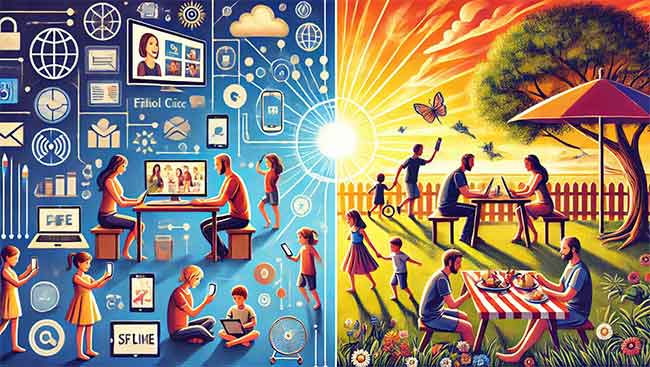
Today, there are about 5.44 billion internet users in the world. Online communication has become more prevalent than ever before. What we are seeing now is that the way we interact with each other is gradually changing toward a more virtual landscape. People rely on digital platforms for work, education, entertainment, and socializing. And due to global improvement in technology and connectivity, this trend is likely to continue.
How does digital communication influence our psychological well-being? What is hidden behind its apparent simplicity and convenience? Let’s figure it out.
The Impact of Digitalization on Child Development
Digital technologies are changing drastically how we perceive the world around us, including how children learn and develop. While the effects of digitalization on child development are still being studied to understand the long-term implications, researchers point to the following.
Childhood is a period of the most active exploration and growth. According to estimates by the Royal Institution of Great Britain, over the past half-century, the radius of space in which children explore the surrounding world has decreased by about 90%. First, they focused on TV screens, then shifted to computers, and now to smartphones.
With smartphones and tablets replacing everything for kids, their activities have significantly decreased. Like any other restriction on children’s activities, this shift to screen time could negatively affect their physical, cognitive, and social spheres.
Specialists warn that an environment deprived of fresh air and varied live interactions, where the development of taste, smell, and touch is not stimulated, cannot be healthy. Moreover, a child raised on social networks loses the ability to empathize. Social platforms cannot teach them the interpersonal skills to get an immediate response from someone they are talking to, respond to nonverbal information, and build a real dialogue.
What About Adults?
Psychologists emphasize the profound benefits of live, face-to-face communication for mental health. Life interactions provide richer, more nuanced personal and social information, enabling a higher level of intimacy and trust. This is because face-to-face communication allows us to pick up on subtle cues such as body language, voice tone, and facial expressions, which are crucial for understanding and empathy.
A study conducted during the COVID-19 lockdown showed that in-person interactions are directly related to mental well-being. It was found that individuals who engaged more in face-to-face communication reported better mental health compared to those limited to digital means only.
Face-to-face communication helps prevent feelings of isolation and encourages social bonding. Plus, it reduces the cognitive load and potential anxiety associated with digital communication, for example, “Zoom fatigue” caused by prolonged eye contact and screen time.
The Pros and Cons of Online Communication
Although the researchers state that technology-mediated communication cannot be a substitute for face-to-face communication, online communication has its undeniable benefits.
Here are some positive aspects of online communication:
- The ability to connect with people worldwide is a significant advantage. This connectivity can foster international friendships, collaborations, and cultural exchange.
- A lot of valuable information as well as learning materials are readily available on the internet, most of which can be accessed freely. This allows for distance learning and self-education on a wide range of topics.
- Online communication provides the flexibility to work and study from any location. We can work remotely, take online courses, and participate in virtual meetings without having to physically attend them.
- Various options to communicate, including text messages, video calls, social media, forums, and more, allow us to choose the most suitable environment for our needs.
- Online platforms may offer support networks for individuals facing similar challenges, be it health issues, parenting, or professional development. We can find emotional support and practical advice here and now; at the moment, we need them most.
However, excessive use of digital communication strikes hard on our well-being. People tend to replace real contacts with online friends. It becomes tempting to create a virtual persona with an ideal life, which leads to feelings of inadequacy when one compares oneself to others online.
A person may experience anxiety or unease in in-person social situations as a result of fewer real-life interactions. In addition, slipping too far into the virtual space can contribute to feelings of isolation and anxiety, and the pressure to be constantly available can be stressful.
So, how can we take advantage of all these online resources while not deteriorating our mental health? The answer is to find the right balance.
Balancing Both Modes
Given the advantages of both face-to-face and digital communication, a balanced approach might be the healthiest choice. These steps can help you maintain a healthy approach toward communication and keep you from becoming overly dependent on internet tools:
- Rely on face-to-face interactions to establish and maintain strong relationships within your social network; utilize digital communication for efficient and convenient communication when necessary.
- Be mindful of the time your kids and you spend before the screen. Prioritize in-person interactions where possible and take breaks from digital devices.
- When using digital platforms, try to support your communication with video calls to add a more personal touch to your conversations.
Promoting Offline Activities
The life we live today revolves around digital devices and screens. Therefore, it is crucial to intentionally plan offline activities for yourself and your family. Outdoor adventures, board games, or simply spending quality time together without the distraction of screens can all work. It may be useful to get to know who lives next door. Hosting a neighborhood BBQ or joining a local club or organization can be great ways to connect with those around you.
Bottom Line
Real-life communication is invaluable for its ability to convey rich, nuanced information. It fosters deeper relationships and provides significant mental and emotional benefits. It is not replaceable by digital tools. At the same time, given the communication opportunities the internet gives us, we cannot help but recognize its power.
What you should remember is that being up-to-date with modern communication technologies doesn’t mean being totally dependent on them. Balance in online/offline interactions is the secret to healthy relationships and the well-being of an individual in today’s interconnected world.
 My Favourites
My Favourites









Speak Your Mind